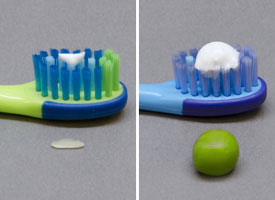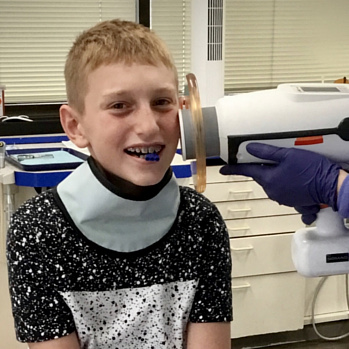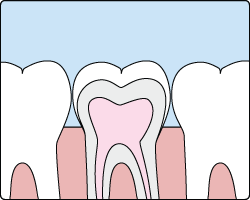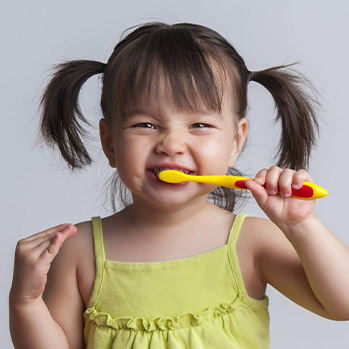Preventive Dental Care in Brookfield
Preventative dental care is important throughout life, especially at a young age. Brookfield’s preventative dental care experts at The Fun Kids Dentist can help your child establishing good habits early by practicing good oral hygiene at home. In addition, by scheduling regular dental cleaning and checkups at our Brookfield office with the dentist. Your child can help keep their smile bright and healthy for many years to come.
Cleanings:
The American Dental Association and the American Academy of Pediatric Dentistry recommend that your child sees a dentist twice per year for a dental checkup and cleaning. Baby teeth are at risk for plaque and tartar just like adult teeth. If the plaque and tartar are not removed from the teeth, they can cause bad breath and bleeding swollen gums which leads to periodontal disease. At your child’s checkup and dental cleaning visit at our Brookfield office, our team will gently remove any plaque and tartar, polish, and floss the teeth. We will examine your child’s teeth and soft tissues, and evaluate their growth and development. We may recommend digital x-rays to help us detect any conditions that are not visible during the exam, or further diagnose any issues we have visually identified. Your child may have a fluoride treatment at the end of the cleaning visit, to help their teeth stay strong!
Fluoride:
Fluoride is a naturally occurring element, which has been shown to prevent tooth decay by as much as 50-70%. Despite the advantages, too little or too much fluoride can be detrimental to the teeth. With little or no fluoride, the teeth aren’t strengthened to help them resist cavities. Excessive fluoride ingestion can lead to dental fluorosis, which is typically a chalky white discoloration of the permanent teeth. At your child’s preventative dental care visit at our Brookfield office, we will discuss your current fluoride usage, including both topical in the form of toothpaste/rinses, etc., and any water fluoridation/systemic fluoride. Be sure to follow your pediatric dentist’s instructions on the suggested use of fluoride use and possible supplements, if needed.
Proper usage of topical fluoride in ADA-approved, over-the-counter fluoride toothpaste is a very safe, and effective way to reduce cavities. The use of fluoridated toothpaste is recommended per AAPD guidelines, for ALL children at the start of tooth eruption, regardless of caries risk.
Fluoride toothpaste for children
For children younger than 3 years, parents and caregivers should begin brushing children’s teeth as soon as they begin to come into the mouth by using fluoride toothpaste in an amount no more than a smear or the size of a grain of rice.
 For children, 3 to 6 years of age, parents, and caregivers should dispense no more than a pea-sized amount of fluoride toothpaste.
For children, 3 to 6 years of age, parents, and caregivers should dispense no more than a pea-sized amount of fluoride toothpaste.
Teeth should be brushed thoroughly twice a day (morning and night) or as directed by a dentist or physician. Children’s brushing should be supervised to ensure that they use the appropriate amount of toothpaste.
Fluoride rinses/mouthwashes are not recommended until at least age 6, or when your child can safely swish and spit the rinse, so as not to ingest the fluoride rinse. Our team typically applies a professional fluoride treatment at child’s twice-yearly preventative dental checkups at our Brookfield office.
Dental Radiographs (X-Rays)

Radiographs are a vital and necessary part of your child’s dental diagnostic process. Without them, cavities, and certain other dental conditions can and will be missed. Radiographs detect much more than cavities. They are needed to survey erupting teeth, diagnose bone diseases, evaluate an injury, or plan orthodontic treatment. They allow dentists to diagnose and treat health conditions that cannot be visually detected during a clinical examination. Radiographs are an important part of preventative dental care at our Brookfield dental practice because, if dental problems are found and treated early, dental care is less invasive, more comfortable for your child, and more affordable for you.
The American Academy of Pediatric Dentistry recommends cavity-detecting radiographs every six to twelve months for most children. Our doctors will assess your child’s individual needs according to their caries risk and exam findings.
Pediatric dentists are particularly careful to minimize the exposure of their patients to radiation. With contemporary safeguards and technology, the amount of radiation received in a dental x-ray is extremely small. Lead thyroid collars/shields are most important and recommended for our growing patients, to help protect your child. Today’s equipment filters out an unnecessary x-ray and restricts the beam to areas of interest. The high-speed digital film also helps to ensure that your child receives a minimal amount of radiation exposure.
Sealants

A sealant is a protective coating that is applied to the chewing surfaces (grooves) and deep anatomy (pits and fissures), typically on the permanent molar teeth. This sealant acts as a barrier to food, plaque, and acid, thus protecting these more vulnerable areas of the teeth. When you come to our office in Brookfield for a preventative dental care visit, our doctors will evaluate your child for their particular risk for cavities in these areas, and whether sealants would be indicated.
Cariology Visits/ "Starfish" Checks
Cariology Visits, or “Starfish Checks” as we like to call them at our office, are a dental visit for children that have a need to visit the office more frequently to become acclimated to the dental environment and/or to monitor their dental health/disease more closely. These visits to our Brookfield office are dental checkups in between the six-month recommended time period for most patients.

